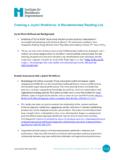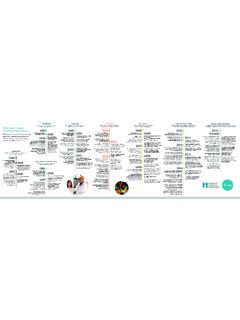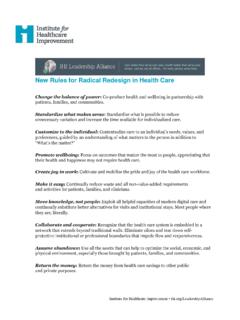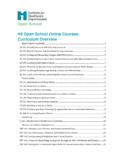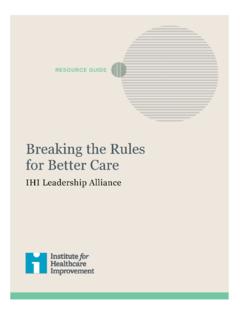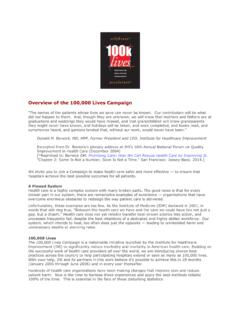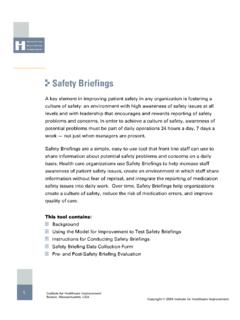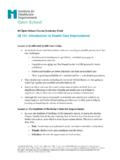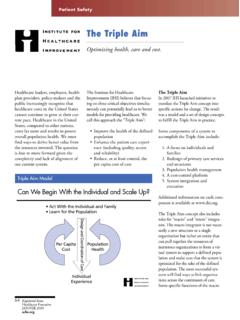Transcription of 5 Million Lives Campaign Case Statement - IHI …
1 5 Million Lives Campaign AN INITIATIVE OF THE institute FOR healthcare improvement institute for healthcare improvement 20 University Road, 7th Floor Cambridge, MA 02138, USA institute for healthcare improvement , 2006 5 Million Lives Campaign I. Origins of the 100,000 Lives Campaign II. The 100,000 Lives Campaign (December 2004 June 2006) III. 100,000 Lives Campaign Results IV. The Next Campaign : 5 Million Lives Campaign V. A Request for Support VI. References Executive Summary On December 14, 2004, at its 16th Annual National Forum on Quality improvement in Health Care, the institute for healthcare improvement (IHI) launched the 100,000 Lives Campaign a national initiative to engage thousands of hospitals in an effort to prevent 100,000 needless inpatient deaths by implementing improvements in care.
2 Declaring that Some is not a number; soon is not a time, Don Berwick, MD, IHI s President and CEO, challenged hospitals to commit to reaching a bold goal: saving 100,000 Lives by June 14, 2006. To help hospitals reach this goal, IHI outlined six clinical interventions that hospitals could focus on to reduce mortality and morbidity. On June 14, 2006, the 100,000 Lives Campaign ended and IHI announced that after 18 months, Campaign hospitals had exceeded the goal of 100,000 Lives saved by a significant margin. Once again, Don Berwick stood before an audience of thousands of people committed to improving health care and declared the result: hospitals participating in the Campaign had prevented an estimated 122,300 needless deaths.
3 This unprecedented result testifies to the willingness of hospitals to participate in this voluntary initiative (an estimated 80 percent of inpatients now receive their care from hospitals participating in the Campaign ) and to the improvements in care they have implemented. After decades of limited traction in improving our troubled health care system, the Campaign appears to have tapped into a new and promising level of energy, dialogue, and will to change. IHI and its many partners are committed to building on the momentum generated by the 100,000 Lives Campaign as we eagerly anticipate the next Campaign , and we invite you to support us in this effort. 5 Million Lives Campaign institute for healthcare improvement , 2006 3 I.
4 Origins of the 100,000 Lives Campaign The quality chasm : A health care system in crisis A half decade has elapsed since the institute of Medicine (IOM) released its two landmark reports on health care safety and quality, To Err Is Human and Crossing the Quality Chasm. Those studies illuminated the shortcomings of the American health care system and articulated a simple yet bold agenda for improving the quality of our health care. The IOM reports made clear that American health care system, which intends to heal, too often does just the opposite leading to unintended harm and unnecessary deaths at alarming rates. Consider just these two statistics: The institute of Medicine estimates that as many as 98,000 people die each year in hospitals due to medical injuries.
5 The Centers for Disease Control and Prevention estimate that two Million patients suffer hospital-acquired infections each year. Compounding the problem is the staggering cost of this inadequate system. Americans spend $ trillion a year over 15 percent of our Gross Domestic Product and over 40 percent more per capita than any other developed nation for a system that performs worse than many others on important dimensions of health care quality. In its landmark 2001 report, Crossing the Quality Chasm: A New Health Care System for the 21st Century, the institute of Medicine articulated six urgently needed Aims for improvement of health care in America: Safety; Effectiveness; Patient-centeredness; Timeliness; Efficiency; and Equity.
6 IHI took up the IOM challenge with its own translation of the IOM s six aims: No Needless No Needless Pain or No Unwanted No Helplessness in those Served or No No One Left Out. IHI: A catalyst for accelerating improvement worldwide During the last 14 years, IHI has invented new solutions to perfect innovation in health care; it has developed will and optimism for change by reducing barriers that traditionally have prevented people and organizations from coming together to cooperate and to share lessons; it has spread new tools and methods for improvement to health care organizations to enable them to turn knowledge into action and improve results; and it is helping to build the future health care workforce by developing young professionals in education programs that reduce profession-specific silos that limit collaborative thinking and efforts.
7 IHI is leading the way to health care improvement by demonstrating what works, by documenting practices that make a difference, and by creating new models for effective and efficient health 5 Million Lives Campaign institute for healthcare improvement , 2006 4 care delivery. No other organization in America has more clinical process improvement information, more evidence of outcomes and results, or a more substantial repository of data and evidence on how efficacy and efficiency can be achieved. Additionally, IHI supports research to document the impact of quality improvement on cost. In short, IHI is uniquely positioned to hold out the promise of significantly re-engineered health care systems, with better care at lower cost.
8 IHI works by leveraging partnerships and channels of influence within the health care community. It changes health care by helping and influencing others to do so, beginning by showing them the possibility of success, and then by supporting them in their own pursuit of success. As a result, IHI developed the IMPACT network, a results-driven network for change that has a growing membership of over 200 hospitals; initiated the Pursuing Perfection project to work intensively with seven hospitals and six international health care sites toward achieving system-wide transformation; and engaged several large and international health care systems in strategic partnerships to spread improvement . These endeavors all serve to provide organizations on the very frontlines of health care delivery with guidance, knowledge, and tools for making breakthrough improvements.
9 Prior to the Campaign , the majority of IHI s improvement initiatives engaged tens and sometimes hundreds of organizations in a single project. The 100,000 Lives Campaign sought to take the next step: working on a scale of thousands and rapidly expanding the reach of organizations to improve quality and lower costs across the country. 5 Million Lives Campaign institute for healthcare improvement , 2006 5 II. The 100,000 Lives Campaign (December 2004 June 2006) The Campaign was well designed and well researched before it was announced in December 2004, and deeply grounded in IHI s previous work. Its components proved so timely and appropriate that the health care community responded immediately. The Campaign asked participating hospitals to implement a set of six evidence-based health care interventions that have been proven to prevent avoidable deaths.
10 To date, more than 3,100 hospitals, representing more than three quarters of the hospitals beds in the country, have signed on. In addition to its explicit goals for mortality reduction and enrollment, the 100,000 Lives Campaign is intent on building a reusable national infrastructure for groundbreaking change, developing and leveraging strong relationships with national partners (listed below), scientific expert groups, local health care associations ( , state hospital associations, nurses associations, and medical societies) and successful mentor hospitals to expand the initiative s reach and increase effectiveness. This national network, focused on maximizing expert support and learning opportunities for participating facilities, could emerge as a major asset in introducing health care improvements in coming years.
